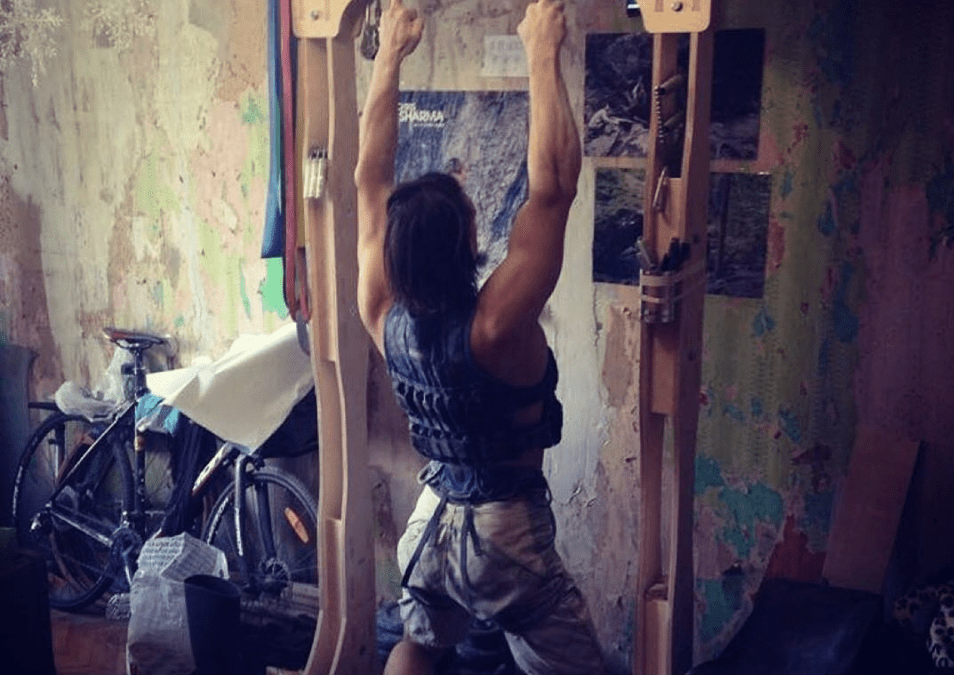The Power Cycle: Stay-At-Home Routine Day 11
Day 11 of a 28-day power-training cycle for the climber looking for strength at home.

Day 11:
Yesterday‘s hangboarding an isometric exercises should have us feeling a little on the weaker side, though our arms should still feel relatively strong. Day 11 will begin our first round of weighted pull-ups. Weighted pull-ups allow a climber to adapt to higher resistance so that when they move to pull, the climber can pull further and faster than before. If you have never completed weighted pull-ups before, it is a game changing exercise that is highly recommended for people looking to increase their top-end power.
Warm Up:
- Warming up will likely differ between people, but these are a few good warm ups.
- Shoulder rolls
- Rotations: hold arms out perpendicular to the length of your body. Your arms should be parallel to the floor. Begin by rotating your wrists clockwise while your arms are straight. Then increase the rotation from the shoulders, maintain g your straight arms. Steadily increase the radius of rotation until your arms are wind milling, then reverse the direction.
- Hang on a bar and retract and relax your shoulders
- Complete a number of pull ups that would warm you up but not tire you out
Agonist muscles:
Once your biceps and shoulders are fully warm, or so warm that you could pull as hard as you would want, begin off-set pull ups.
Weighted Pull-ups:
Weighted pull-ups are fairly easy to execute and, though they may not feel fatiguing over the course of the exercise, exceptionally taxing on the body. As such, it is important that they are executed with proper pull-up form. If you do not have weights, try to fill a back pack with water bottles. Each litre of water is equal to a kilogram.
- First, pick a weight that is below your limit and complete four pull-ups with that weight. If it feels like you can increase the weight, do so for the next set of four pull ups. Continue this process until you find the maximum weight with which you are able to execute good form. This will be your training weight.
- Complete three sets of three repetitions at that weight. We are completing three reps as opposed to one because climbing is made up of more than one hard move, most of the time, and it is difficult to build strength when completing a single repetition per set. Instead, use your one-rep maximum, if you are interested in finding it, as a test instead of as training.
Core:
For Day 11 we will maintain a fairly high level of repetitions in our core exercises. We will reduce this number slightly in an effort to perfect our form. On the leg-lifts especially, strive for perfect form. Remember, perfect form means no swing and straight legs.
Hanging leg-lifts:
Beginner: 10 sets of 5 repetitions: bring the legs up so that your body makes a 90-degree angle
Moderate: 10 sets of 5 repetitions: bring your feet to the bar
Expert: 10 sets of 10 repetitions: feet to bar
The 5-minute Core Destroyer:
- One minute each of the following exercises:
- Plank
- big kicks
- swimmer kicks
- V-Sit
- big kicks
- There is no rest between each exercise, instead rest at the conclusion of all five exercises. Then rest for five minutes and repeat the series twice more.
Antagonist Muscles:
Push-ups: High Intensity
Complete 5, 7, or 10 repetitions depending on your skill level per exercise on Day 11. Once that is established…
Complete the following exercises three times in a row for a total of nine sets. Your total push-up count for the day will be either 45, 63, or 90 repetitions.
- elbows-back push-ups: complete 5-10 then rest 30 seconds
- diamond push-ups: complete 5-10 then rest 30 seconds
- archer push-ups: complete 5-10 then rest 30 seconds
Flexibility:
Hold each stretch for 15-30 seconds:
- Straddle Splits: This stretch is important to climbing as it increases a climber’s lateral flexibility for moves like stemming in a corner.
- Hamstring: keep your legs straight and bend down to your feet. Keep your back flat for an alternate version of this stretch.
- Hip-flexor: Flexible hip-flexors allow a climber to high-step.
- Quadricep: preventative against injury
- Triceps stretch: preventative against injury
- Shoulder stretch: increases mobility
- Calf stretch: increased heel-hooking mobility
Featured Photo by Artem Solomin.


